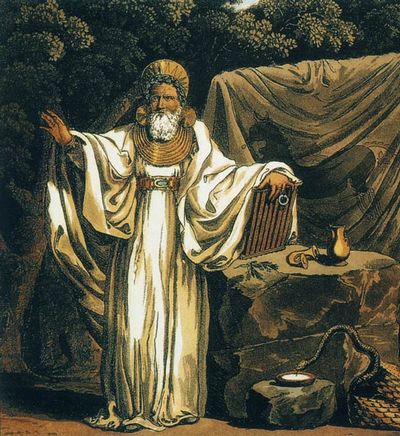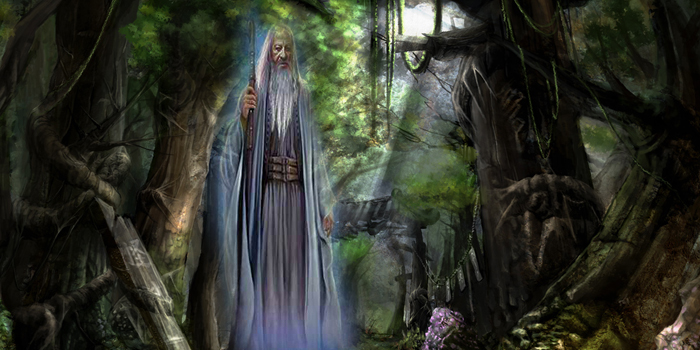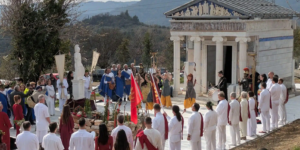 The Celtic people spread from their homeland in what is now Germany across Europe in the first millennium bce. Iron tools and weapons rendered them superior to their neighbors. They were also skilled farmers, road builders, traders and inventors of a fast two-wheeled chariot. They declined in the face of Roman, Germanic and Slavic ascendency by the second centuries bce.
The Celtic people spread from their homeland in what is now Germany across Europe in the first millennium bce. Iron tools and weapons rendered them superior to their neighbors. They were also skilled farmers, road builders, traders and inventors of a fast two-wheeled chariot. They declined in the face of Roman, Germanic and Slavic ascendency by the second centuries bce.
Here Peter Berresford Ellis, one of Europe’s foremost experts of the Celts, explains how modern research has revealed the amazing similarities between ancient Celt and Vedic culture. The Celt’s priestly caste, the Druids, has become a part of modern folklore. Their identity is claimed by New Age enthusiasts likely to appear at annual solstice gatherings around the ancient megaliths of northwest Europe. While sincerely motivated by a desire to resurrect Europe’s ancient spiritual ways, Ellis says these modern Druids draw more upon fanciful reconstructions of the 18th century than actual scholarship.
The Druids of the ancient Celtic world have a startling kinship with the brahmins of the Hindu religion and were, indeed, a parallel development from their common Indo-European cultural root which began to branch out probably five thousand years ago. It has been only in recent decades that Celtic scholars have begun to reveal the full extent of the parallels and cognates between ancient Celtic society and Vedic culture.
 The Celts were the first civilization north of the European Alps to emerge into recorded history. At the time of their greatest expansion, in the 3rd century bce, the Celts stretched from Ireland in the west, through to the central plain of Turkey in the east; north from Belgium, down to Cadiz in southern Spain and across the Alps into the Po Valley of Italy. They even impinged on areas of Poland and the Ukraine and, if the amazing recent discoveries of mummies in China’s province of Xinjiang are linked with the Tocharian texts, they even moved as far east as the area north of Tibet.
The Celts were the first civilization north of the European Alps to emerge into recorded history. At the time of their greatest expansion, in the 3rd century bce, the Celts stretched from Ireland in the west, through to the central plain of Turkey in the east; north from Belgium, down to Cadiz in southern Spain and across the Alps into the Po Valley of Italy. They even impinged on areas of Poland and the Ukraine and, if the amazing recent discoveries of mummies in China’s province of Xinjiang are linked with the Tocharian texts, they even moved as far east as the area north of Tibet.
The once great Celtic civilization is today represented only by the modern Irish, Manx and Scots, and the Welsh, Cornish and Bretons. Today on the northwest fringes of Europe cling the survivors of centuries of attempted conquest and “ethnic cleansing” by Rome and its imperial descendants. But of the sixteen million people who make up those populations, only 2.5 million now speak a Celtic language as their mother tongue.
The Druids were not simply priesthood. They were the intellectual caste of ancient Celtic society, incorporating all the professions: judges, lawyers, medical doctors, ambassadors, historians and so forth, just as does the brahmin caste. In fact, other names designate the specific role of the “priests.” Only Roman and later Christian propaganda turned them into “shamans,” “wizards” and “magicians.” The scholars of the Greek Alexandrian school clearly described them as a parallel caste to the brahmins of Vedic society.
The very name Druid is composed of two Celtic word roots which have parallels in Sanskrit. Indeed, the root vid for knowledge, which also emerges in the Sanskrit word Veda, demonstrates the similarity. The Celtic root dru which means “immersion” also appears in Sanskrit. So a Druid was one “immersed in knowledge.”
Because Ireland was one of the few areas of the Celtic world that was not conquered by Rome and therefore not influenced by Latin culture until the time of its Christianization in the 5th century ce, its ancient Irish culture has retained the most clear and startling parallels to Hindu society.
Professor Calvert Watkins of Harvard, one of the leading linguistic experts in his field, has pointed out that of all the Celtic linguistic remains, Old Irish represents an extraordinarily archaic and conservative tradition within the Indo-European family. Its nominal and verbal systems are a far truer reflection of the hypothesized parent tongue, from which all Indo-European languages developed, than are Classical Greek or Latin. The structure of Old Irish, says Professor Watkins, can be compared only with that of Vedic Sanskrit or Hittite of the Old Kingdom.
The vocabulary is amazingly similar. The following are just a few examples:
Old Irish – arya (freeman),Sanskrit – aire (noble)
Old Irish – naib (good), Sanskrit – noeib (holy)
Old Irish – badhira (deaf), Sanskrit – bodhar (deaf)
Old Irish – names (respect), Sanskrit – nemed (respect)
Old Irish – righ (king), Sanskrit – raja (king)
 This applies not only in the field of linguistics but in law and social custom, in mythology, in folk custom and in traditional musical form. The ancient Irish law system, the Laws of the Fénechus, is closely parallel to the Laws of Manu. Many surviving Irish myths, and some Welsh ones, show remarkable resemblances to the themes, stories and even names in the sagas of the Indian Vedas.
This applies not only in the field of linguistics but in law and social custom, in mythology, in folk custom and in traditional musical form. The ancient Irish law system, the Laws of the Fénechus, is closely parallel to the Laws of Manu. Many surviving Irish myths, and some Welsh ones, show remarkable resemblances to the themes, stories and even names in the sagas of the Indian Vedas.
Comparisons are almost endless. Among the ancient Celts, Danu was regarded as the “Mother Goddess.” The Irish Gods and Goddesses were the Tuatha De Danaan (“Children of Danu”). Danu was the “divine waters” falling from heaven and nurturing Bíle, the sacred oak from whose acorns their children sprang. Moreover, the waters of Danu went on to create the great Celtic sacred river–Danuvius, today called the Danube. Many European rivers bear the name of Danu–the Rhône (ro- Dhanu, “Great Danu”) and several rivers called Don. Rivers were sacred in the Celtic world, and places where votive offerings were deposited and burials often conducted. The Thames, which flows through London, still bears its Celtic name, from Tamesis, the dark river, which is the same name as Tamesa, a tributary of the Ganges.
Not only is the story of Danu and the Danube a parallel to that of Ganga and the Ganges but a Hindu Danu appears in the Vedic story “The Churning of the Oceans,” a story with parallels in Irish and Welsh mytholgy. Danu in Sanskrit also means “divine waters” and “moisture.”
In ancient Ireland, as in ancient Hindu society, there was a class of poets who acted as charioteers to the warriors They were also their intimates and friends. In Irish sagas these charioteers extolled the prowess of the warriors. The Sanskrit Satapatha Brahmana says that on the evening of the first day of the horse sacrifice (and horse sacrifice was known in ancient Irish kingship rituals, recorded as late as the 12th century) the poets had to chant a praise poem in honor of the king or his warriors, usually extolling their genealogy
and deeds.
Such praise poems are found in the Rig Veda and are called narasamsi. The earliest surviving poems in old Irish are also praise poems, called fursundud, which trace back the genealogy of the kings of Ireland to Golamh or Mile Easpain, whose sons landed in Ireland at the end of the second millennium bce. When Amairgen, Golamh’s son, who later traditions hail as the “first Druid,” set foot in Ireland, he cried out an extraordinary incantation that could have come from the Bhagavad Gita, subsuming all things into his being
Celtic cosmology is a parallel to Vedic cosmology. Ancient Celtic astrologers used a similar system based on twenty-seven lunar mansions, called nakshatras in Vedic Sanskrit. Like the Hindu Soma, King Ailill of Connacht, Ireland, had a circular palace constructed with twenty-seven windows through which he could gaze on his twenty-seven “star wives.”
 There survives the famous first century bce Celtic calendar (the Coligny Calendar) which, as soon as it was first discovered in 1897, was seen to have parallels to Vedic calendrical computations. In the most recent study of it, Dr. Garret Olmsted, an astronomer as well as Celtic scholar, points out the startling fact that while the surviving calendar was manufactured in the first century bce, astronomical calculus shows that it must have been computed in 1100 bce.
There survives the famous first century bce Celtic calendar (the Coligny Calendar) which, as soon as it was first discovered in 1897, was seen to have parallels to Vedic calendrical computations. In the most recent study of it, Dr. Garret Olmsted, an astronomer as well as Celtic scholar, points out the startling fact that while the surviving calendar was manufactured in the first century bce, astronomical calculus shows that it must have been computed in 1100 bce.
One fascinating parallel is that the ancient Irish and Hindus used the name Budh for the planet Mercury. The stem budh appears in all the Celtic languages, as it does in Sanskrit, as meaning “all victorious,” “gift of teaching,” “accomplished,” “enlightened,” “exalted” and so on. The names of the famous Celtic queen Boudicca, of ancient Britain (1st century ce), and of Jim Bowie (1796-1836), of the Texas Alamo fame, contain the same root. Buddha is the past participle of the same Sanskrit word–“one who is enlightened.”
For Celtic scholars, the world of the Druids of reality is far more revealing and exciting, and showing of the amazingly close common bond with its sister Vedic culture, than the inventions of those who have now taken on the mantle of modern “Druids,” even when done so with great sincerity.
 If we are all truly wedded to living in harmony with one another, with nature, and seeking to protect endangered species of animal and plant life, let us remember that language and culture can also be in ecological danger. The Celtic languages and cultures today stand on the verge of extinction. That is no natural phenomenon but the result of centuries of politically directed ethnocide. What price a “spiritual awareness” with the ancient Celts when their culture is in the process of being destroyed or reinvented? Far better we seek to understand and preserve intact the Celt’s ancient wisdom. In this, Hindus may prove good allies.
If we are all truly wedded to living in harmony with one another, with nature, and seeking to protect endangered species of animal and plant life, let us remember that language and culture can also be in ecological danger. The Celtic languages and cultures today stand on the verge of extinction. That is no natural phenomenon but the result of centuries of politically directed ethnocide. What price a “spiritual awareness” with the ancient Celts when their culture is in the process of being destroyed or reinvented? Far better we seek to understand and preserve intact the Celt’s ancient wisdom. In this, Hindus may prove good allies.
The Song of Amairgen the Druid I am the wind that blows across the sea; I am the wave of the ocean; I am the murmur of the billows; I am the bull of the seven combats; I am the vulture on the rock; I am a ray of the sun; I am the fairest of flowers; I am a wild boar in valor; I am a salmon in the pool; I am a lake on the plain; I am the skill of the craftsman; I am a word of science; I am the spearpoint that gives battle; I am the God who creates in the head of man the fire of thought. Who is it that enlightens the assembly upon the mountain, if not I? Who tells the ages of the moon, if not I? Who shows the place where the sun goes to rest, if not I? Who is the God that fashions enchantments– The enchantment of battle and the wind of change?
Amairgen was the first Druid to arrive in Ireland. Ellis states, “In this song Amairgen subsumes everything into his own being with a philosophic outlook that parallels the declaration of Krishna in the Hindu Bhagavad-Gita.” It also is quite similar in style and content to the more ancient Sri Rudra chant of the Yajur Veda.

































2 Comments